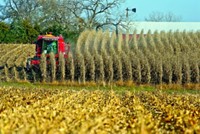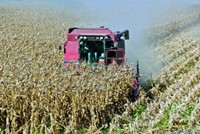Advertisement
Grab your lab coat. Let's get started
Welcome!
Welcome!
Create an account below to get 6 C&EN articles per month, receive newsletters and more - all free.
It seems this is your first time logging in online. Please enter the following information to continue.
As an ACS member you automatically get access to this site. All we need is few more details to create your reading experience.
Not you? Sign in with a different account.
Not you? Sign in with a different account.
ERROR 1
ERROR 1
ERROR 2
ERROR 2
ERROR 2
ERROR 2
ERROR 2
Password and Confirm password must match.
If you have an ACS member number, please enter it here so we can link this account to your membership. (optional)
ERROR 2
ACS values your privacy. By submitting your information, you are gaining access to C&EN and subscribing to our weekly newsletter. We use the information you provide to make your reading experience better, and we will never sell your data to third party members.
Environment
Bruce Dale
Michigan State chemical engineer takes a critical look at the pluses and minuses of biofuels
by Stephen K. Ritter
February 14, 2011
| A version of this story appeared in
Volume 89, Issue 7
Bruce E. Dale often plays the role of devil's advocate not only against the rosy picture of biofuels painted by start-ups and trade associations but also against the gloom-and-doom message of some environmental groups. That's because he's devoted to developing meaningful methods to compare the economic, national security, and environmental value of the various renewable transportation fuels now vying to extend and eventually replace petroleum-derived fuels.
Dale is a chemical engineering professor at Michigan State University and a lead scientist in the Great Lakes Bioenergy Research Center. He is well-known for conducting life-cycle analyses of biobased fuels and chemicals.
Any biofuels conversation with Dale eventually turns toward the importance of making realistic comparisons. "To properly compare fuels, we need appropriate metrics," Dale says. Energy return on investment, or EROI, is perhaps the key metric for comparing different fuel types, he believes.
"You must 'invest' energy to produce energy, whether it is drilling for oil or growing corn," he explains. An EROI of 5:1 is a reasonable benchmark value, Dale says. "Below this value, all we would have time to do is produce energy. Nothing else would be possible—no recreation, arts, or education. Those activities require that we have lots of surplus energy."
Gasoline's EROI on average is about 15:1 and is decreasing as oil gets harder to find and refine, Dale notes. Cellulosic ethanol's is also about 15:1 and is increasing as the technology improves. Corn ethanol and soybean biodiesel weigh in at around 2:1 or 3:1—net positive but below the threshold for large-scale use.
A key national security metric is the "liquid fuel return on investment"—the liquid fuel output versus liquid fuel used, Dale says. For cellulosic and corn ethanol, it is very favorable at 20:1, because only a small amount of petroleum is needed to produce ethanol. For gasoline, however, the value is negative, because it takes petroleum to produce petroleum.
"In effect, ethanol is a way to leverage petroleum to produce lots more liquid fuel," he points out. "That is one reason why corn ethanol is a better deal for us than most people realize."
Dale says he often battles the misperception that using corn to make biofuel will compromise food supplies and create environmental problems. "Food grains in the U.S. are predominantly wheat and rice, not corn," Dale points out. "If we can get past the emotional 'food versus fuel' reaction, it's clear that we use arable land mostly to grow animal feed, not food directly.
"We should focus on feeding ourselves an adequate diet first—that is nonnegotiable," Dale continues. "Then we can start looking at discretionary uses of land, including land for biofuel production. Do we really need so many steaks and hamburgers and so much high-fructose corn syrup? Probably not. Those are food choices, not true food needs."
To illustrate this point, Dale and his colleagues conducted a modeling study in which they redesigned how U.S. land is used. They created scenarios that included growing more double crops, such as winter rye, that would supply additional biomass for fuels.
Dale's team found that using less than 30% of total cropland, pasture, and range, the U.S. could produce 100 billion gal of ethanol per year—about half of the U.S.'s transportation fuel needs—without reducing domestic supplies of food, animal feed, and fiber or decreasing agricultural exports (Environ. Sci. Technol., DOI: 10.1021/es101864b). This approach would also reduce total U.S. greenhouse gas emissions by about 10% per year.
"People have the gut feeling that we are using our agricultural land efficiently," Dale says. "But we are not."
In addition, too many people think that cellulosic ethanol technology is developing too slowly and should be jettisoned in favor of other biofuels, Dale says. "There are good reasons for developing other biofuels, especially aviation fuels, but these will take many years to develop and roll out," Dale observes. "We have ethanol now and it is a fine fuel; the problem is market access."
Until last fall, the regulated blend rate for ethanol in U.S. gasoline had been stuck at 10%, and expansion of the cellulosic ethanol industry stalled because corn ethanol was already supplying this 10% limit. The blend rate is now 15% for cars made after 2001. Passenger vehicles can safely handle ethanol blends up to 20% without modification, according to Environmental Protection Agency tests.
Ethanol and other emerging biofuels could be better accommodated in the current fuel distribution infrastructure by adding "blender pumps" at service stations, Dale argues. At the pump consumers could dial in the percentage of ethanol or biofuel they want to mix with a petroleum-derived fuel, or use a pure biofuel.
"We are letting the fuel infrastructure tail wag the national energy security dog," Dale says. "If the U.S. decided that all new cars sold here must be flex-fuel, the demand for biofuels would go up, demand for petroleum would go down, and petroleum prices would stabilize globally because there would be greater competition and choice in the transportation fuels market.
"People tend to think we are technology limited," Dale adds. "Better biofuel technology is on the way, but adopting biofuels is more a matter of our choices rather than hard technical or resource constraints. If we make simple policy choices such as producing flex-fuel vehicles and installing blender pumps, we can have tens of billions of gallons of biofuels on the market in a decade or two."






Join the conversation
Contact the reporter
Submit a Letter to the Editor for publication
Engage with us on Twitter